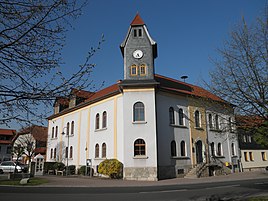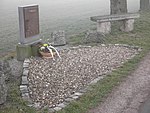Great Gods
|
Great Gods
Rural community of Unstrut-Hainich
|
|
|---|---|
| Coordinates: 51 ° 8 ′ 46 ″ N , 10 ° 33 ′ 50 ″ E | |
| Height : | 182 m above sea level NHN |
| Area : | 19.34 km² |
| Residents : | 2286 (December 31, 2017) |
| Population density : | 118 inhabitants / km² |
| Incorporation : | 1st January 2019 |
| Postal code : | 99991 |
| Area code : | 036022 |
|
town hall
|
|
Großengottern is a district of the rural community Unstrut-Hainich in the Unstrut-Hainich district in Thuringia .
geography
Großengottern is located in the northern Thuringian Basin between the two cities of Mühlhausen and Bad Langensalza . The location of Großengottern is in the area of the Innerthuringian Ackerhügelland , the north and with the "Gotternschen Ried" also the east of the localization in the Unstrutaue between Mühlhausen and Bad Langensalza. The highest elevation is therefore at 220 m above sea level on Kammerforster Weg west of the town, the lowest at around 173 m above sea level on the Unstrut in the far east of the district. Other elevations are two former impact slope areas of the Unstrut, the 193.3 m high Hopfenberg northeast and the 193.6 m high Schalkenberg southeast of the village. The Gotternsche Flur is mainly used for agriculture, arable farming predominates. Poplar forests are located on the southern edge of the "Gotternschen Ried" and with the Großengottern dam , a reservoir originally created for irrigation of the fields.
history
The place was first mentioned in the year 811. According to Wolfgang Kahl , the first mention of Großengottern took place on March 13, 1253.
In the area of the Walpurgis cemetery there was once a castle site. The church and the cemetery are most likely on the site of the medieval manor castle. The gatehouse from the cemetery in 1580 and the church tower, built in 1494, still show the defensive strength of the area.
In the first half of the 14th century, the Mülverstedter convent of the Wilhelmite Order acquired a plot of land in Großengottern in order to set up a hospital. The village chapel of St. Andreas probably emerged from this complex around 1347. In the 15th century the hospital was called the "Leprosenhaus"; it was one of the 39 previously known leprosories in Thuringia. The system was further modified in the 18th and 19th centuries. The gentlemen von Hopffgarten had converted the property into a retirement home. The last resident is a woman known as Katzenbertha . From 1958 to 1990 a local museum was housed in the former hospital.
In the late Middle Ages and in the early modern period, the Lords of Seebach owned the mayor's office combined with market rights and castle fiefs in Großengottern.
The place belonged to the Electoral Saxon Office Langensalza until 1815 and after its cession to Prussia from 1816 to 1944 to the district of Langensalza in the province of Saxony .
On March 4, 1949, a four-engine US supply aircraft for the Berlin Airlift exploded and crashed between Großengottern and Heroldishausen. Four of the five crew members were able to save themselves with parachutes, Lieutenant RC Stephens lost his life. He was honored in 1999 by erecting a plaque on a road near the crash site. During the GDR era, the crash was kept secret as far as possible.
Since 1993, Großengottern has been a member and administrative seat of the Unstrut-Hainich administrative community , whose member communities, with the exception of Schönstedt, merged to form the Unstrut-Hainich rural community on January 1, 2019 .
Churches
politics
The council of the community of Großengottern consisted of 14 council women and councilors. He was re-elected every five years.
| Parties and constituencies | 2014 | 2009 | 2004 | 1999 | 1994 | ||||||||||
|---|---|---|---|---|---|---|---|---|---|---|---|---|---|---|---|
| Share a | Seats | Share a | Seats | Share a | Seats | Share a | Seats | Share a | Seats | ||||||
| Christian Democratic Union of Germany | CDU | 13.5 | 2 | 14.8 | 2 | 52.3 | 8th | 48.9 | 7th | 42.2 | 6th | ||||
| Free Democratic Party | FDP | 14.7 | 2 | 18.5 | 3 | 38.5 | 5 | 29.2 | 4th | 26.0 | 4th | ||||
| Free community of voters - For our great gods | FWG | 71.8 | 10 | 66.7 | 9 | - | - | - | - | - | - | ||||
| Social Democratic Party of Germany | SPD | - | - | - | - | 9.2 | 1 | 21.9 | 3 | 31.9 | 4th | ||||
| percentage of invalid votes | 4.2 | 4.0 | 5.0 | 5.4 | 5.2 | ||||||||||
| Total seats | 14th | 14th | 14th | 14th | 14th | ||||||||||
| voter turnout | 50.7% | 50.9% | 54.8% | 57.2% | 76.4% | ||||||||||
The honorary and non-party mayor Thomas Karnofka was elected on September 14, 1997 and was last re-elected on June 5, 2016 with 98.5% of the votes.
Culture and sights
- Protestant churches of St. Martini and St. Walpurgis with rectory and gateway to the churchyard
- The former hospital “St. Andreaskapelle ”consisted of the hospital building, the chapel and two outbuildings. The chapel was a single-storey building with a gable roof. A small bell tower rises above the west gable.
- Village museum with the remains of a post-milestone pillar from 1729 in the courtyard. At that time the place belonged to the Duchy of Saxony-Weißenfels . The village museum is part of a larger facility with an exhibition of old agricultural machinery and tractors on the grounds of the "Hornhardtschen Rittergut". You can also see two of the four engines of an American "raisin bomber" that crashed near Großengottern on March 4, 1949 and was on its way to West Berlin, which was blocked by the Red Army , for the airlift from West Germany .
- War memorial for the fallen of both world wars
- Commemorative plaque for an aviator who died in the crash of a US American “raisin bomber” in March 1949. The memorial, erected in 1999, is located about 3 km west of Großengottern on Kammerforster Weg, just before its intersection with the road from Heroldishausen to Seebach.
Economy and Infrastructure
traffic
Großengottern has a train station on the Gotha – Leinefelde railway line . The federal road 247 runs through the village, which guarantees good transport connections but is a heavy burden. A bypass was already promised to the village in 1991, but has not yet been implemented (2019).
Established businesses
- Creaton AG, manufacturer of clay roof tiles
- F&T Solarpark Großengottern: set up a photovoltaic system in 2010 for 6.5 million euros on an area of 4.45 hectares near Großengottern, which is supposed to provide an annual output of 2 million kilowatt hours.
- Swiss Sauerkonserven GmbH
Personalities
- Ernst Christian Hesse (1676–1762), conductor, composer and viol player
- Friderika Baldinger (1739–1786), writer
- Carl von Seebach (1809–1877), local politician, co-owner of the Wahlhof in Großengottern
- Karl Ferdinand Haltaus (1811–1848), historian and poet
- Uda Heller (* 1951), politician (CDU), member of the Bundestag
- Olaf Rahardt (* 1965), marine painter, grew up in Großengottern
- Uwe Reipert (* 1960), heraldist
Others
- As evidence of coarse folk humor, neck names and nicknames that characterize each village developed centuries ago . According to this, Grotengottersche Zippeltrater - onion treaders , also Zippellatscher - lived here in the village : onion cultivation was widespread in the village, so that onions did not bloom, the onions were kicked over. The pickled cucumber is known as Gottersche Bratwurst .
Individual evidence
- ^ Wolfgang Kahl : First mention of Thuringian towns and villages. A manual. 5th, improved and considerably enlarged edition. Rockstuhl, Bad Langensalza 2010, ISBN 978-3-86777-202-0 , p. 101.
- ↑ Michael Köhler: Thuringian castles and fortified prehistoric and early historical living spaces. Jenzig-Verlag Köhler, Jena 2001, ISBN 3-910141-43-9 , p. 263.
- ^ Christiane Rossner: Drums for the smallest hut. The hospital ensemble in Großengottern could soon no longer be complete. In: Monuments . Vol. 25, No. 2, 2015, pp. 22-26.
- ^ Hospital St. Andreas. In: German Foundation for Monument Protection. Retrieved March 6, 2018 .
- ↑ Claudia Götze: Raisin Bombers are still anchored in memories. Even 65 years after the crash, humanitarian aid from American airlift pilots has not been forgotten. In: Thüringische Landeszeitung , March 3, 2014.
- ↑ Thuringian Law and Ordinance Gazette No. 14/2018 p. 795 ff. , Accessed on January 13, 2019
- ↑ 2014 municipal council elections in Thuringia - final result. In: wahlen.thüringen.de. Retrieved March 4, 2018 .
- ↑ 2009 municipal council elections in Thuringia - final result. In: wahlen.thüringen.de. Retrieved March 4, 2018 .
- ^ 2004 municipal council elections in Thuringia - final result. In: wahlen.thüringen.de. Retrieved March 4, 2018 .
- ^ 1999 municipal council elections in Thuringia - final result. In: wahlen.thüringen.de. Retrieved March 4, 2018 .
- ^ 1994 municipal council elections in Thuringia - final result. In: wahlen.thüringen.de. Retrieved March 4, 2018 .
- ↑ Mayoral elections in Thuringia - election of September 14, 1997. In: wahlen.thüringen.de. Retrieved March 6, 2018 .
- ↑ Mayoral elections in Thuringia - election on June 5, 2016. In: wahlen.thüringen.de. Retrieved March 6, 2018 .
- ^ NN: VG Unstrut-Hainich Großengottern. St. Andreas village church . In: moment. The culture magazine for the Hainichland . No. 3, 2005, ZDB -ID 2192647-5 , p. 23-24 .
- ↑ 6.5 million euros for a solar system. In: Thüringische Landeszeitung , April 10, 2010.
- ↑ Rolf Aulepp: Nicknames of the places and their residents in the Mühlhausen district. In: Eichsfelder Heimathefte. Vol. 27, No. 1, 1987, ISSN 0232-8518 , pp. 78-83.






